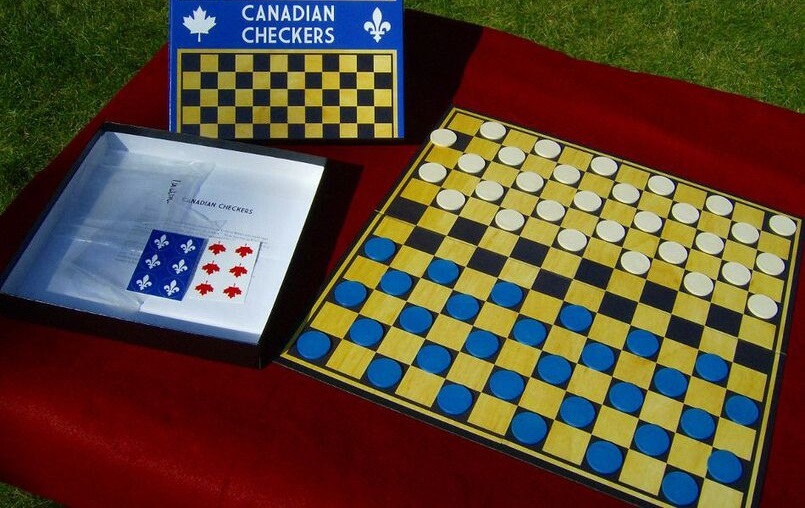Canadian checkers, also called Canadian draughts, is a variant of draughts game. It is played on a board with 30 pawns on each side and 12×12 (144 squares).
Canadian Checkers History
Canadian checkers is played mainly by the French settlers of Quebec concentrated in the northeast of North America, while the game of International Checkers (also called “Polish or French”) is practiced in more than 50 countries! There are also other draughts variants (played on 64 squares): Russian, Brazilian, Italian, Spanish, Turkish, etc.
Canadian Checkers rules
The rules of the Canadian and international game are the same. The only differences are in the number of squares (144 for the Canadian and 100 for the International) and the pieces (30 for each player for the Canadian and 20 for the International).
In the 64-box game, there are several variants. The Brazilian game uses the same rules as the Canadian and the International. The difference between the Russian game and, among other things, the majority taking, which is not compulsory. The English game, also called “Checkers”, practiced on 64 spaces has however rules which differ more: a player cannot take backwards with the pieces, the king can move backward and also take backwards but cannot fly.
Difference between English and Canadian rules
Here are the rules that differ from the Polish checkers game:
- The pawn can never move backward, even when jumping.
- The king moves in all directions, but only one square at a time.
- In case of capture, the king must land on the free square immediately next to the last captured piece.
- A player who has the choice between several takes is not required to make the movement which allows him to capture the most enemy pieces, but, if he has chosen this one, he must make all the possible captures.
As in international draughts, it is allowed to pass several times over an empty square, but, it is forbidden to jump more than once over the same piece.
Regulations (Quebec version)
Here are the detailed rules for Canadian checkers:
- The game of checkers is played by two persons on a checkerboard of one 144 squares.
- The board should be placed so that the long diagonal line is placed to the left of each player.
- There are on the dark squares of the first four rows on each side 30 black pawns and 30 white.
- The game then begins. The game consists in taking or immobilizing all the pieces of the opponent. The game is a draw if the competitors have one or more impregnable pieces.
- White always starts the game first.
- The players move alternately, a piece to a left or a right square, at the rate of only one square per move.
- Pieces cannot move backwards.
- A piece touched, must be played.
- When a pawn arrives to an opposing pawn whose back square is unoccupied, it jump over this pawn, lands on this square and capture it; and if possible, he takes, under the same conditions, a second, a third pawn, etc.
- The catches are made forwards and / or backwards, they are obligatory.
- Captured pieces must only be removed after the FULL jump (or multi-jump) has been completed.
- You are required to remove the pieces in the order in which they were taken.
- In a multi-jump, we go back to the same empty square as many times as the jump requires, but not over a piece already taken.
- If a piece reaches the last row in the opponent side (in a simple move or at the end of a jump), it is crowned with another piece of its color. These two stacked pieces are now a “king”.
King’s moves:
- The king can go all at once, but always diagonally, all the squares of a line, forwards and backwards, on the right as on the left, if no obstacle prevents it.
- The king takes, at any distance whatsoever, any piece followed by one or more empty boxes. And when, in its path, it crosses a line where there is captured pieces, it must change the direction and collect these pieces. The most important (majority) catch is MANDATORY.
- We are free to capture a king OR a simple piece if the two are eligible. The value of the piece doesn’t matter.
- If you have to take the same number of pieces with a pawn or a king, you are free to do it with the pawn or the king.

